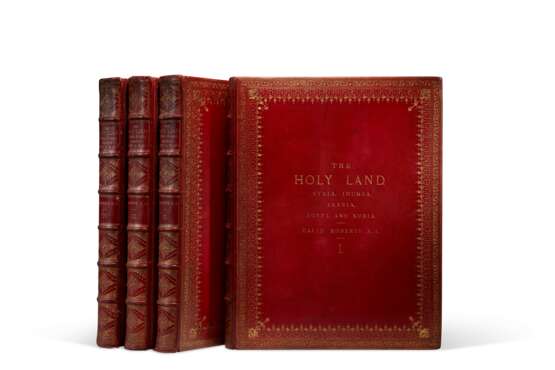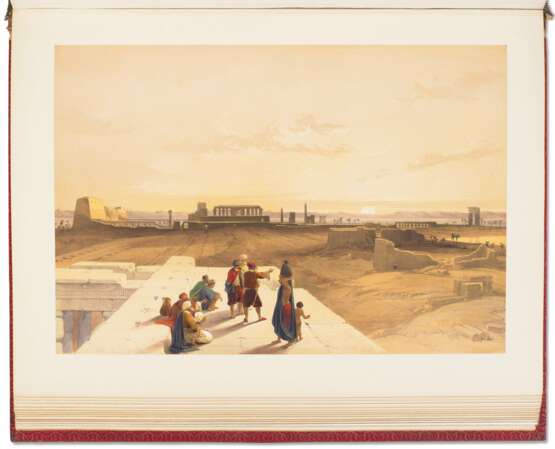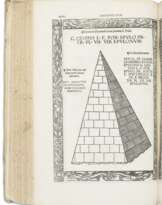ID 627547
Los 57 | The Holy Land
Schätzwert
$ 100 000 – 150 000
First edition of the most desirable hand-colored issue of the "apotheosis of the tinted lithograph," in contemporary red morocco (Abbey). David Roberts' visual travel diary is masterfully translated into print by Louis Haghe's lithography, and he paid tribute to Haghe's work in glowing terms: "Haghe has not only surpassed himself, but all that has hitherto been done of a similar nature. He has rendered the views in a style clear, simple and unlaboured, with a masterly vigour and boldness which none but a painter like him could have transferred to stone." John Ruskin, who did not often have high praise for either Roberts's work in particular or travel art in general, described the collection as "the first studies ever made conscientiously by an English painter, not to exhibit his own skill, or to make capital out of his subjects, but to give true portraiture of scenes of historical and religious interest. They are faithful and laborious beyond any outlines from nature I have ever seen." The lush and immersive lithograph scenes invite the viewer into Roberts' orientalist landscape, which presents a Romantic view of the Levant aimed at conjuring the authenticity of the Bible more than a scientific record of the region.
After an apprenticeship to the Scottish house-painter, Gavin Buego, Roberts had become an assistant scene painter at the Pantheon theatre in Edinburgh. But by 1830 Roberts was firmly established as a topographical artist and was able to give up his work in the theatre. He began to plan his journey to the Near East in 1838, and in August 1839 departed for Alexandria, spending the remainder of the year in Cairo and visiting the major tombs and sites of Egypt. The following February he journeyed to the Holy Land, making stops in Suez, Mount Sinai, and Petra. He spent time in Gaza before entering Jerusalem and concluded his tour by spending several months becoming familiar with the biblical sites of the Holy Land. On his way home once again via Alexandria, he was granted an audience with Mehemet Ali, accompanied by British officials who were in the area to seek support for an overland trade route to India via Egypt; the Suez canal would not open until 1869.
Roberts returned to England at the end of 1839 and submitted his drawings to F. G. Moon in 1840. They were exhibited at the Royal Academy and well received, but Roberts was keen to take advantage of lithography to reach the widest possible audience for his work. This book, sold by subscription, provided to Britain "a corpus of visual material that was to influence Western perceptions of Egypt and the Holy Land through the rest of the century" (Burritt). The complete work was published in 3 states: tinted, with tinted proofs, and colored and mounted on card (as here); there were also later editions in smaller formats. Abbey, Travel 272 and 385; Tooley 401. See Amanda Burritt, Visualising Britain’s Holy Land in the Nineteenth Century (2002).
Six volumes in four, folio (600 x 436mm). Lithographic titles to each volume, 2 maps, 248 hand-colored lithographs mounted on card (some very light spotting mostly in first two volumes, largely confined to margins but affecting pale areas of a few lithographs; corner dampstain in vol 2 affecting text and title page to part 3). Contemporary red morocco gilt by Ramage, London, edges gilt (a little superficial wear at joints, a few scuffs).
| Künstler: | William Shakespeare (1564 - 1616) |
|---|---|
| Angewandte Technik: | Bleistift |
| Künstler: | William Shakespeare (1564 - 1616) |
|---|---|
| Angewandte Technik: | Bleistift |
| Adresse der Versteigerung |
CHRISTIE'S 8 King Street, St. James's SW1Y 6QT London Vereinigtes Königreich | |
|---|---|---|
| Vorschau |
| |
| Telefon | +44 (0)20 7839 9060 | |
| Aufgeld | see on Website | |
| Nutzungsbedingungen | Nutzungsbedingungen |

















